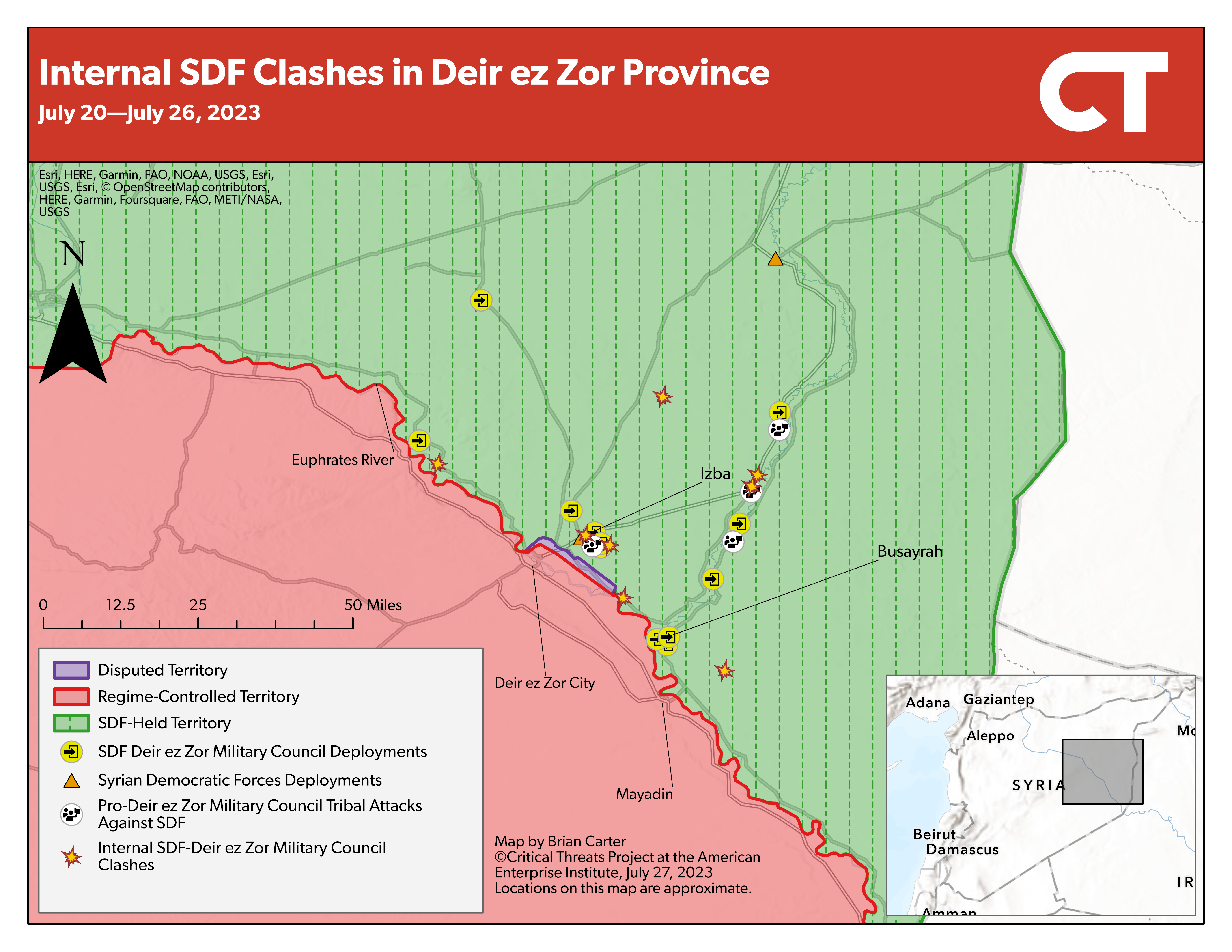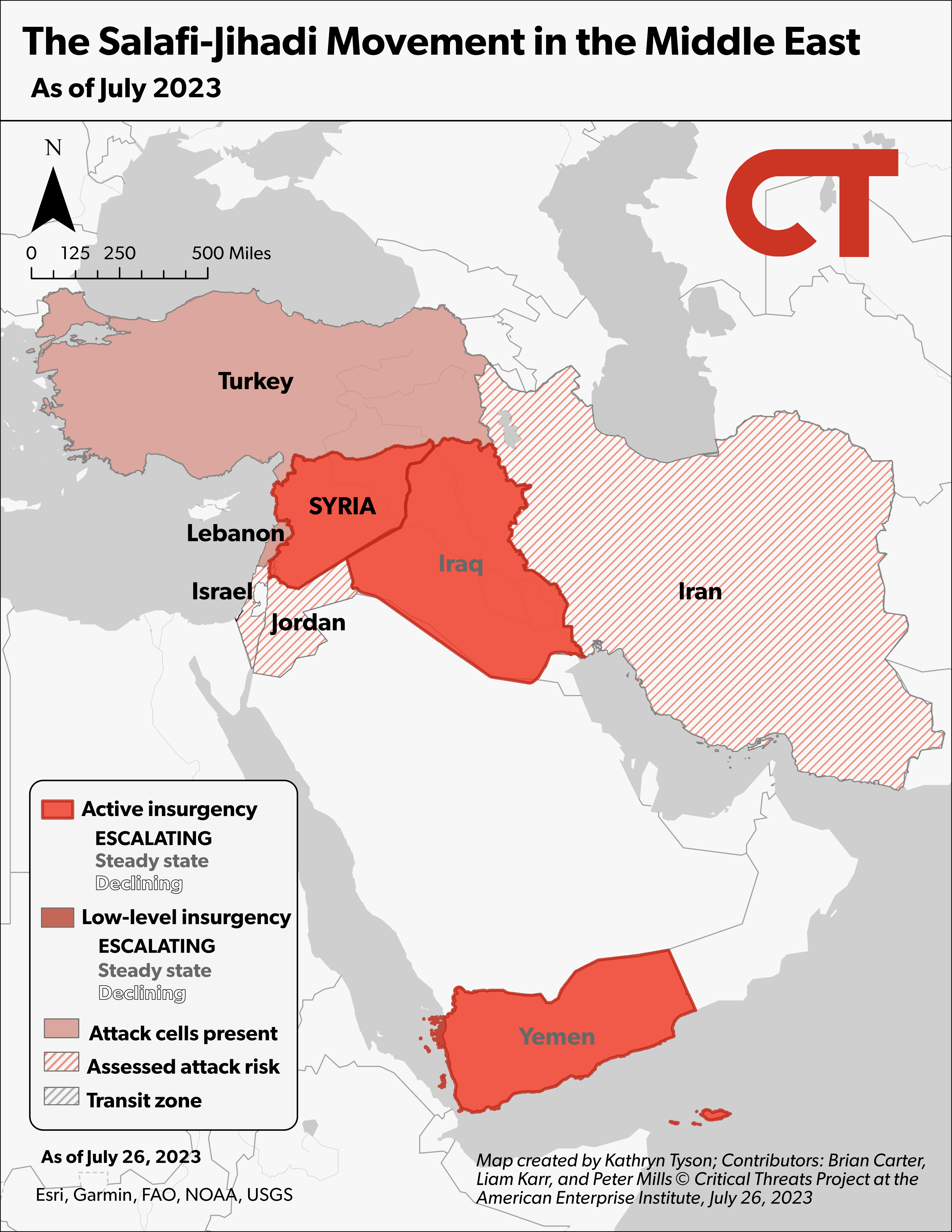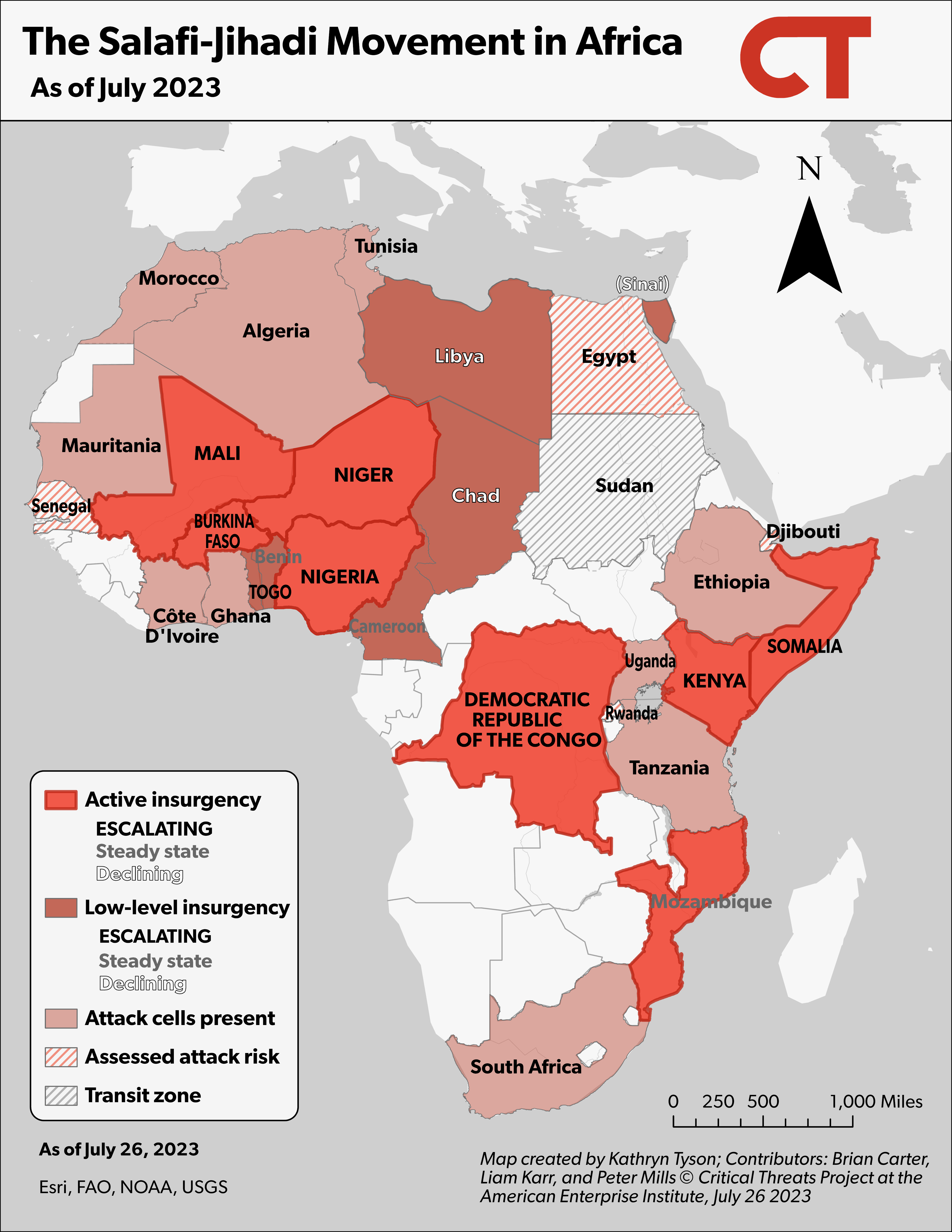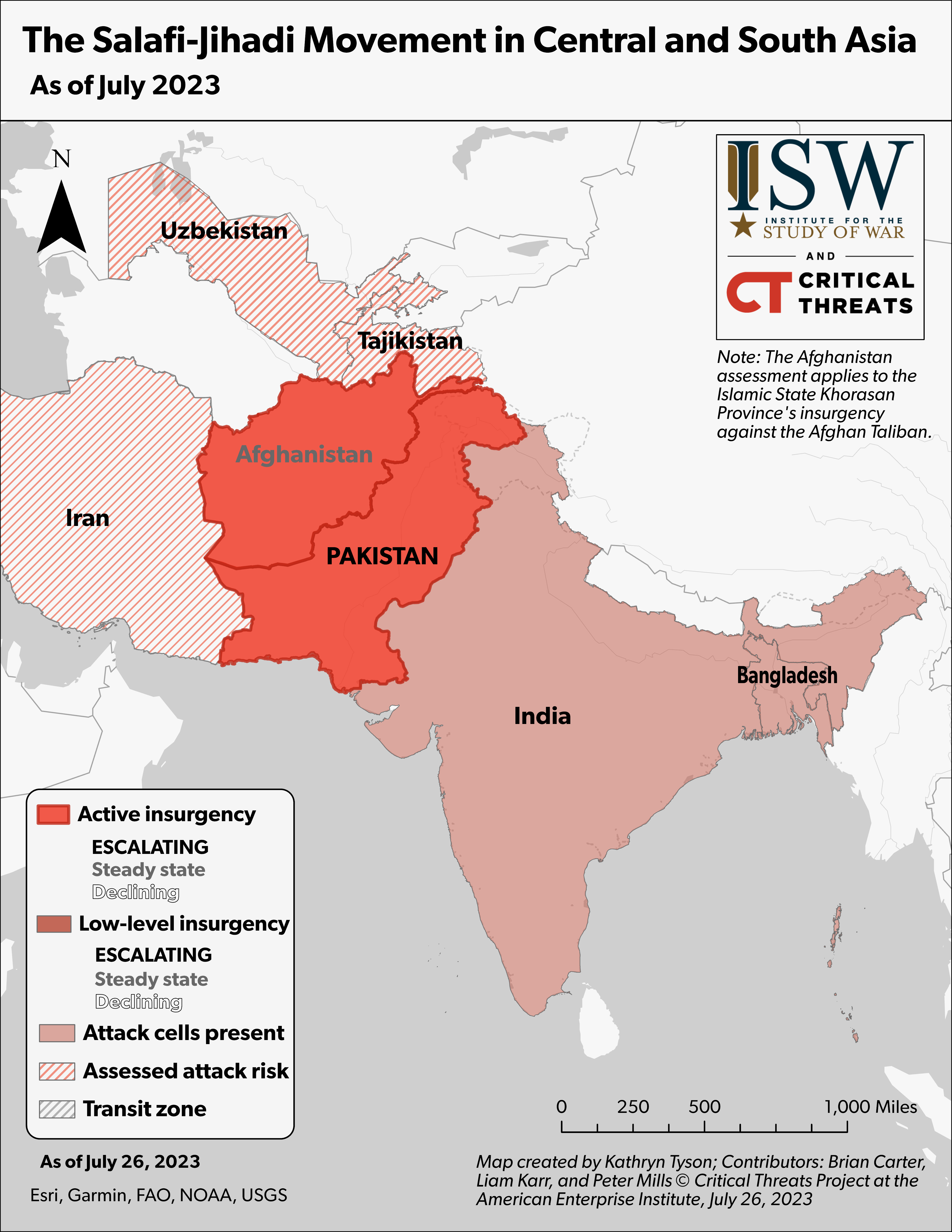 |
 |
Salafi-Jihadi Movement Weekly Update, July 26, 2023

Salafi-Jihadi Movement Weekly Update, July 26, 2023
Authors: Brian Carter, Liam Karr, and Peter Mills
Data Cutoff: July 26, 2023, at 10 a.m. CTP will cover subsequent information in the August 2, 2023, Salafi-Jihadi Movement Weekly Update.
Key Takeaways:
Iraq and Syria. Russian acts of aggression against the United States in Syria aim to expel the United States from Syria through sustained, low-grade military pressure. Iranian, Russian, and Syrian regime efforts to expel the United States are causing a decrease in counterinsurgent pressure on ISIS. ISIS is not defeated and retains significant latent capabilities in Syria. Internal friction within the US-backed Syrian Democratic Forces (SDF) is also contributing to a decrease in counterinsurgent pressure. ISIS is likely conducting operations under the assumption that the United States will withdraw in the near term—and preparing to take advantage of a US withdrawal.
Niger. A successful coup in Niger would likely strengthen al Qaeda and the Islamic State by preoccupying Nigerien security forces and hindering international security cooperation as coups have elsewhere in the Sahel. A successful coup would almost certainly negatively impact Niger’s role as the last remaining Western partner in the tri-border area of Burkina Faso, Mali, and Niger and the largest recipient of US State Department military assistance in West Africa. Russia could also exploit an isolated junta government to evade Western sanctions.
Pakistan. The Tehrik-e Taliban Pakistan (TTP) is concentrating attacks near Peshawar, northwestern Pakistan, in a likely effort to build support zones that will allow it to facilitate cross-border movement from Afghanistan, run training camps, and carry out more sophisticated attacks in Pakistan. This supports the TTP’s effort to exert control over rural terrain in Pakistan. TTP support zones could also allow affiliated transnational Salafi-jihadi groups, such as al Qaeda, to plan and conduct attacks beyond Pakistan.
Afghanistan. Islamic State Khorasan Province (ISKP) is likely directing cells in Turkey from Afghanistan to attack European targets in Turkey. ISKP also exerts command and control over cells in northern Syria that could attack European targets. ISKP is seeking to carry out an attack against Swedish targets as retaliation for the burning of a Quran on June 28. ISKP could use a successful attack against European targets to support its campaign to delegitimize the Taliban government among its hard-line supporters.
Assessments:
Iraq and Syria. Russian intercepts of US aircraft in Syria are acts of aggression that aim to expel US forces from Syria through sustained, low-grade military pressure and could disrupt the United States’ ability to defeat ISIS by making Syria a less permissive environment for US operations. Russian fighter jets damaged two US MQ-9 Reaper drones conducting counter-ISIS operations over Syria in separate incidents on July 23 and 26, the latest in a major increase in Russian aggression in Syria in 2023.[1]
Russian aggression against the United States in Syria is a military campaign coordinated with Iran and the Assad regime aimed at expelling the United States from Syria, which would begin to a fulfill a long-standing Russian goal of diminishing US influence in the Middle East.[2] The US military mission in Syria is tasked with defeating ISIS.[3] Russian aggression targeting US aircraft, coupled with the efforts of Iran and the Assad regime, are making Syria a less permissive environment for US forces by taking actions that threaten the lives of US personnel. Russia has previously sought to decrease the ability of US and NATO forces to operate in other theaters in an effort to prevent US and NATO forces from accomplishing their objectives.
ISIS is not defeated and retains significant latent capabilities in Syria. ISIS has coerced support from the population in semi-urban areas on both sides of the river. Both pro-regime and pro-opposition Syrian sources report ISIS “owning the night” in towns along the Euphrates.[4] ISIS can use support zones on both sides of the river as sanctuaries when counterinsurgent pressure increases on either side of the river.[5] ISIS is already conducting a multi-effort campaign to create additional support in regime-held and SDF-held Syria.[6] ISIS seeks to free imprisoned veteran fighters from SDF prisons; support zones support that effort by providing free zones where ISIS can build the logistical assets, such as vehicle-borne improvised explosive devices, planning cells, and munitions, that would permit it to launch attacks against prisons.[7]
Counterinsurgent pressure on ISIS is decreasing as counterinsurgent forces in Syria prioritize each other instead of ISIS. Russia, the Syrian regime, and Iran are currently focused on expelling the United States from Syria, at the expense of some counter-ISIS operations.[8] The SDF is still conducting counter-ISIS operations, but it is intermittently faced with bandwidth constraints caused by choices to respond to Turkish air strikes and incursion threats.[9] The SDF focuses on targeted raids that generally fail to create lasting effects on ISIS. The SDF does not regularly mount clearing and holding operations that would force ISIS from an area and then secure the population.[10] ISIS leverages these distractions to carry out major operations. A pause in Russian air strikes helped enable ISIS to mass fighters for a major offensive in central Syria in early 2023.[11]
Figure 1. Internal SDF Clashes in Deir ez Zor Province, July 20–26, 2023
Source: Brian Carter.
The SDF is also contending with internal frictions that could inhibit its operations in Deir ez Zor. The Arab SDF commander in Deir ez Zor has been attempting to expand his footprint in northeastern Syria, causing the SDF consternation.[12] The SDF attempted to deploy forces to curtail his influence beginning on July 19, causing clashes with the Arab commander’s forces on July 25.[13] The US mission in Syria mediated an agreement between the two parties, but the causes of the clashes remain.[14] These tensions damage counterinsurgent pressure by drawing SDF focus away from ISIS and toward each other.
The reduction of counterinsurgent pressure enables ISIS to strengthen its capabilities and support structures in Syria. ISIS views its strength positively in central Syria, where it has claimed three attacks since June 22.[15] ISIS had not claimed an attack in Hama since December 2022, and it explicitly acknowledged underreporting attacks to protect itself in central Syria.[16] The group is using its strength in central Syria to launch operations against the regime-held semi-urban Deir ez Zor belt, where it is increasingly coercing financial and logistical support from the population.[17] Demonstrators flew ISIS flags in SDF-held Izba, Deir ez Zor, in early July, pointing to a level of latent support among the population there.[18]
ISIS is likely conducting operations under the assumption that the United States will withdraw within 3 years and is preparing for a resurgence after the withdrawal. ISIS is setting favorable conditions for a resurgence by improving its ability to recruit in northeastern Syria by undermining SDF governance and intimidating the population to prevent their cooperation with the SDF. It is already infiltrating pro-regime forces in regime-held Syria.[19] ISIS is also building support zones to gather and protect financial and logistical resources to execute major campaigns and operations, including prison breaks, after a US withdrawal.
Additional indicators that would suggest accelerated ISIS preparation for US withdrawal include ISIS efforts to prepare to exploit tribal rifts caused by uncertainty after a withdrawal, such as the co-optation of tribal leaders under the guise of protecting the tribe from its tribal rivals, the regime, or Kurdish SDF forces. [20] ISIS also undertook a similar effort in Deir ez Zor in 2014, and its predecessor, al Qaeda in Iraq, prepared for the US withdrawal from Iraq by undertaking an amateur ethnographic effort to better understand how to exploit and leverage Iraq’s Sunni tribes.[21] Any reports of shadow governance, such as courts, would also suggest a major acceleration.
Figure 2. The Salafi-Jihadi Movement in the Middle East
Source: Kathryn Tyson.
Niger. The outcome of the attempted coup in Niger on July 26 is unclear. The Nigerien presidential guards besieged the presidential palace and surrounding ministries in Niamey on July 26, sealing President Mohamed Bazoum inside the palace and forcing negotiations.[22] Jeune Afrique reported that President Bazoum had been considering sacking the presidential guards’ head in the days before the attempted coup.[23]
The presidential guards lack broader support, however. Other Nigerien defense and security forces did not join the presidential guards. The presidential Twitter account and independent journalists say that President Bazoum is safe inside the palace and that the Nigerien Armed Forces and national guard have remained loyal to the president and are prepared to retake the palace.[24] Loyalist forces have also seized the area near the national broadcasting station to prevent coup forces from taking the building.[25] Pro-Bazoum protests in Niamey also indicate the coup plotters lack popular support.[26]
Coups elsewhere in the Sahel have strengthened the regional al Qaeda and Islamic State affiliates. Both the al Qaeda and Islamic State affiliates in the Sahel have strengthened significantly since coups in Mali in 2021 and Burkina Faso in 2022 caused a decrease in international security assistance.[27] The coups in the Sahel accelerate the Salafi-jihadi insurgency’s spread by distracting security forces with maintaining military juntas, alienating international partners, and abusing civilians.[28] The fallout from the coups led to the withdrawal of significant French contingents from both countries and has led the UN to end its decade-long peacekeeping mission in Mali by the end of 2023.[29]
A successful coup in Niger would likely further strengthen al Qaeda and the Islamic State by preoccupying Nigerien security forces and hindering international security cooperation. Niger is the last remaining Western partner in the tri-border area of Burkina Faso, Mali, and Niger after the coups in Burkina Faso and Mali.[30] Several countries, including France and the US, have soldiers stationed in Niger or are planning to withdraw their troops from Mali to Niger after the end of the UN mission.[31] These Western forces work alongside Nigerien troops to degrade Salafi-jihadi sanctuaries along Niger’s borders.[32]
Niger is also the largest recipient of US State Department military assistance in West Africa and the second highest in sub-Saharan Africa.[33] US law mandates that the government must stop all foreign aid except democratic assistance to countries where the military overthrows a democratically elected government, although a new waiver gives the secretary of state and federal agencies a process to waive the restriction if it is in the US national security interest.[34]
Russia could exploit a new junta government to evade Western sanctions. Russian information operations have boosted popular anti-Western and pro-Russian sentiment in Niger, like many other countries across the Sahel.[35] Russia capitalized on this sentiment and the anti-Western junta in Mali to secure a deal to deploy the Wagner Group in 2021, and it has explored deals with the Burkinabe junta since at least 2022.[36] President Bazoum planning to sack the presidential guards’ commander before the coup—and reports that Bazoum’s predecessor who appointed the commander is mediating negotiations—indicates that the coup is more related to internal power-sharing disputes than counterterrorism issues or geopolitical preferences.[37]
The coup plotters could still use anti-Western sentiment to rally a popular support base, given the coup’s lack of support among the armed forces, and an internationally isolated government is more likely to turn to Russia for security assistance. Niger has significant uranium deposits that would aid Russia’s sanctions-evasion efforts.[38] However, the fallout of the Wagner Group’s rebellion in Russia in June will limit Russia’s capacity to take advantage of the coup, due to Wagner’s outsized role in Russian assistance in Africa.[39]
An unsuccessful coup would still create opportunities for Salafi-jihadi insurgents while security forces are preoccupied. Security forces rotating to eastern Niger for Nigerien Independence Day on August 3 returned to Niamey to help thwart the coup attempt, which will decrease pressure on the Islamic State affiliate that operates in the Lake Chad Basin.[40] Security forces in western Niger have also presumably moved toward the capital to stop the coup. Al Qaeda’s regional associate evicted several villages in southwestern Niger in July, and the resulting decrease in counterterrorism pressure could allow them to consolidate a foothold in this area.[41]
Figure 3. The Salafi-Jihadi Movement in Africa
Source: Kathryn Tyson.
Figure 4. TTP Activity in Afghanistan and Attacks in Northwestern Pakistan
Source: Peter Mills.
Pakistan. The TTP is focusing its attacks near Peshawar, possibly to rebuild support zones around Peshawar to run training camps, support attacks into Peshawar, and facilitate cross border movement to and from Afghanistan. The TTP more than tripled attacks targeting Pakistani security forces in Bara Tehsil, Khyber district, southwest of Peshawar in June and July compared to early 2023.[42] These attacks have destroyed local police stations and checkpoints, which will make it harder for the Pakistani security forces to maintain counterterrorism pressure that restricts TTP militants from crossing the Afghan-Pakistan border near Bara. The TTP is also undermining the local security forces’ morale by kidnapping and assassinating local police.[43] These tactics mirror the Afghan Taliban’s successful 2021 campaign, which aggressively targeted Afghan security forces’ morale to induce them to surrender.[44]
The attacks support the TTP’s efforts to exert control over rural terrain in Pakistan and may expand its attack zones in and around Peshawar.[45] The TTP is trying to assert control over territory in the former Federally Administered Tribal Areas of Pakistan as part of its campaign to reverse Pakistani constitutional reforms and eject the Pakistani military from the area.
Support zones in Bara would serve as TTP safe havens in Pakistan and enable the TTP to mass more forces and conduct larger attacks.[46] The TTP previously used Bara Tehsil for these purposes.[47] The TTP maintained strongholds in the west of Bara along the border with Afghanistan before Pakistani military operations cleared the area, starting from 2014.[48] The support zones also would enable the TTP to facilitate the movement of fighters and weapons from Afghanistan to Pakistan. CTP previously reported the TTP is assembling improvised explosive devices (IED) in Afghanistan for use in Pakistan.[49]
The establishment of TTP support zones around Peshawar would have the following implications:
- The TTP or other affiliated transnational Salafi-jihadi groups, such as al Qaeda, could use support zones to support efforts to conduct attacks beyond Pakistan. The TTP maintains a relationship with al Qaeda and has previously sheltered other transnational terror groups that seek to conduct attacks abroad.[50] The TTP also shares networks with ISKP, which has sought to conduct attacks beyond Pakistan.[51]
- The TTP could use support zones near Peshawar to attack the Peshawar military garrison and senior government and military officials. This supports the TTP objective to force Pakistani officials to deploy security forces in Peshawar at the expense of deploying them in rural terrain, which enables TTP to expand its support zones in rural areas. The TTP previously attacked the Pakistani military garrison in Zhob, Balochistan, which CTP assessed could strain the Pakistan military’s ability to counter the TTP.[52]
- TTP could use support zones near Peshawar to extract more resources from civilians to fund its operations. The TTP extorts money from most wealthy businessmen and individuals in Peshawar and Swat.[53] Pakistani security forces are failing to combat the problem.[54]
Afghanistan. ISKP militants in Afghanistan are likely directing cells in Syria and Turkey to target European diplomatic facilities in Turkey. Turkish intelligence arrested ISKP militants under suspicion of planning attacks on Swedish and Dutch diplomatic facilities and churches in Istanbul.[55] ISKP called for violent retaliation against Sweden after it allowed a burning of the Quran on June 28.[56] Turkish police arrested an ISKP-linked Tajik national involved in recruitment in June.[57] ISKP previously used its networks in Turkey to secure financing for the group in Afghanistan as early as 2021 and maintain ties with central IS leaddership in Iraq and Syria, but it can use these same networks to direct attacks against European targets, as indicated by Turkey’s repeated arrest of ISKP militants.
ISKP may also direct Islamic State cells in Idlib, Syria, to conduct attacks on European targets. IS cells composed of Uzbek and Tajik nationals located in Idlib, northern Syria, began turning to ISKP for direction in February 2022, after the US killed former IS leader Abdullah Qardash.[58] ISKP directed these Uzbek and Tajik cells to shift attacks to target religious minorities, mirroring an ISKP campaign in Afghanistan, demonstrating ISKP’s command and control over these IS cells.[59] ISKP supporters called for violent retaliation against Sweden in response to the Quran burning in July.[60] A successful ISKP attack on European targets would benefit ISKP by raising its profile among Salafi-Jihadi groups—which have not successfully carried out revenge attacks targeting Sweden.
ISKP could use an attack in Europe to support its campaign to delegitimize the Taliban government. ISKP has previously tried to induce hard-line Taliban supporters to defect to ISKP.[61] The Taliban responded to the Quran burning on July 11, banning Swedish nongovernmental organizations from operating in Afghanistan. This indicates it remains concerned about hard-line criticism.[62] On July 13, ISKP propaganda characterized the Taliban government’s response as weak and condemned it for continuing to maintain diplomatic ties with Western governments.[63]
Figure 5. The Salafi-Jihadi Movement in Central and South Asia
Source: Kathryn Tyson.
[1] https://www.afcent.af.mil/News/Article/3468819/russian-unprofessional-behavior-over-syria-23-july-2023; https://www.wsj.com/articles/russian-attack-on-u-s-drone-spurs-fears-of-...
[2] https://www.understandingwar.org/sites/default/files/PLANEX%20Report%202%20FINALFINAL_7.pdf; https://www.criticalthreats.org/analysis/salafi-jihadi-movement-update-special-edition-iran-russia-and-syrian-prioritization-of-challenging-the-united-states-over-isis-will-present-isis-with-space-to-grow-its-capabilities-rest-and-refit
[4] https://twitter.com/thesyrianlions/status/1682147409088970752?s=20; https://npasyria dot com/151923
[6] https://www.criticalthreats.org/analysis/ending-the-us-presence-in-syria-could-cause-a-rapid-isis-reconstitution-and-threaten-core-us-national-security-interests
[7] https://www.criticalthreats.org/analysis/isis-will-leverage-improved-attack-capabilities-to-generate-forces-in-syria
[8] https://www.criticalthreats.org/analysis/salafi-jihadi-movement-update-special-edition-iran-russia-and-syrian-prioritization-of-challenging-the-united-states-over-isis-will-present-isis-with-space-to-grow-its-capabilities-rest-and-refit
[10] Author’s research; https://www.criticalthreats.org/analysis/ending-the-us-presence-in-syria-could-cause-a-rapid-isis-reconstitution-and-threaten-core-us-national-security-interests; https://www.criticalthreats.org/analysis/salafi-jihadi-movement-weekly-update-may-4-2023
[13] https://www.alaraby dot co.uk/node/6849309; https://shaam dot org/news/syria-news/anbaa-an-azl-alkhbyl-sraa-khfy-byn-qsd-wwajhtha-alaskryh-bdyralzwr; https://twitter.com/Sharqya_reporte/status/1684108060661366784; https://twitter.com/Sharqya_reporte/status/1683850329228468224
[15] https://jihadology.net/2023/06/22/new-issue-of-the-islamic-states-newsletter-al-naba-396; ISIS claim available on request.
[16] https://www.counterextremism.com/blog/isis-redux-central-syria-insurgency-june-2023; https://jihadology.net/2022/07/28/new-issue-of-the-islamic-states-newsletter-al-naba-349
[18] https://www.criticalthreats.org/analysis/salafi-jihadi-movement-update-special-edition-local-protests-suggest-new-isis-support-zone-in-northeastern-deir-ez-zor-syria
[19] https://twitter.com/thesyrianlions/status/1683597095654105092?s=20; https://www.crisisgroup.org/middle-east-north-africa/east-mediterranean-mena/syria/containing-resilient-isis-central-and-north
[20] https://www.carep-paris.org/wp-content/uploads/2023/05/Felix_Legrand_tibalisme_politique_DeirEzzor.pdf
[21] https://www.tandfonline.com/doi/abs/10.1080/09592318.2020.1713529; https://www.carep-paris.org/wp-content/uploads/2023/05/Felix_Legrand_tibalisme_politique_DeirEzzor.pdf
[22] https://www.reuters.com/world/africa/soldiers-nigers-presidential-guard-blockade-presidents-office-security-sources-2023-07-26; https://www.aljazeera.com/news/2023/7/26/soldiers-holding-niger-president-inside-palace-security-source; https://www.jeuneafrique.com/1467056/politique/au-niger-tentative-de-coup-detat-contre-mohamed-bazoum
[23] https://www.jeuneafrique.com/1467056/politique/au-niger-tentative-de-coup-detat-contre-mohamed-bazoum
[24] https://twitter.com/PresidenceNiger/status/1684165019787984898?s=20; https://twitter.com/julienfanciulli/status/1684238871179952130?s=20; https://twitter.com/HousseyneAg/status/1684225179801583617?s=20; https://twitter.com/Wamaps_news/status/1684215910498705408?s=20
[25] https://twitter.com/julesdhl/status/1684196337150046208?s=20; https://twitter.com/Wamaps_news/status/1684215910498705408?s=20
[26] https://twitter.com/almouslime/status/1684242305975300115?s=20; https://twitter.com/almouslime/status/1684243659162628115?s=20; https://twitter.com/konate90/status/1684241536718974990?s=20
[27] https://www.criticalthreats.org/analysis/salafi-jihadi-movement-weekly-update-may-10-2023#Sahel20230510; https://www.criticalthreats.org/analysis/salafi-jihadi-movement-weekly-update#Mali20230714
[28] https://africacenter.org/spotlight/mali-catastrophe-accelerating-under-junta-rule; https://www.bbc.com/news/world-africa-62052598; https://www.hrw.org/news/2023/06/29/burkina-faso-unlawful-killings-disappearances-army
[29] https://www.voanews.com/a/french-forces-complete-departure-from-mali-/6702201.html; https://www.reuters.com/world/africa/burkina-faso-marks-official-end-french-military-operations-its-soil-2023-02-19; https://www.criticalthreats.org/analysis/salafi-jihadi-movement-weekly-update#Mali20230714
[30] https://www.criticalthreats.org/briefs/africa-file/africa-file-burkina-faso-coup-signals-deepening-governance-and-security-crisis-in-the-sahel
[31] https://www.france24.com/en/live-news/20230523-in-niger-france-tests-out-new-strategy-for-africa-operation; https://www.cnn.com/2018/05/10/politics/niger-american-troops-presence/index.html; https://www.dw.com/en/german-ministers-visit-niger-mali-as-military-focus-changes/a-65291853; https://finabel.org/european-forces-to-relocate-from-mali-to-niger-in-fight-again-jihadist-insurgents; https://www.aljazeera.com/news/2022/4/22/niger-debates-hosting-more-european-forces-withdrawing-from-mali
[32] https://www.criticalthreats.org/analysis/salafi-jihadi-movement-weekly-update-april-19-2023#Sahel20230419
[35] https://www.bbc.com/news/world-africa-64451376; https://www.thenewhumanitarian.org/news-feature/2023/02/28/why-niger-protest-france-anti-jihadist-campaign-interviews
[36] https://www.bbc.com/news/world-africa-64451376; https://www.criticalthreats.org/briefs/africa-file/africa-file-wagner-group-deployment-to-mali-threatens-counterterrorism-efforts; https://www.criticalthreats.org/briefs/africa-file/africa-file-wagner-group-in-burkina-faso-will-help-the-kremlin-and-hurt-counterterrorism
[37] https://www.jeuneafrique.com/1467056/politique/au-niger-tentative-de-coup-detat-contre-mohamed-bazoum; https://www.africaintelligence.com/west-africa/2022/09/30/bazoum-struggles-to-emancipate-himself-from-predecessor-issoufou; https://twitter.com/HousseyneAg/status/1684225179801583617?s=20
[39] https://www.criticalthreats.org/analysis/salafi-jihadi-movement-special-edition-wagner-will-remain-in-africa
[41] https://reliefweb.int/report/niger/ocha-niger-mouvement-de-population-dans-le-departement-de-say-update-1-situation-des-deplacements-au-10-juillet-2023
[42] Author’s research.
[43] https://twitter.com/cozyduke_apt29/status/1676841601291911169; https://twitter.com/KhyberScoop/status/1680543466168647681?s=20; https://twitter.com/AfghanAnalyst2/status/1680571824524996610
[44] https://www.atlanticcouncil.org/blogs/new-atlanticist/how-the-taliban-did-it-inside-the-operational-art-of-its-military-victory
[45] https://ctc.westpoint.edu/the-tehrik-i-taliban-pakistan-after-the-talibans-afghanistan-takeover
[47] https://www dot dawn dot com/news/1173892
[48] https://www dot dawn dot com/news/1173892; https://ctc.westpoint.edu/the-revival-of-the-pakistani-taliban; https://www.nydailynews.com/news/world/pakistan-military-kills-32-militants-killed-tirah-valley-article-1.2050737
[49] https://www.understandingwar.org/backgrounder/salafi-jihadi-movement-weekly-update-june-28-2023
[50] https://www.cnn.com/2022/12/15/middleeast/taliban-afghan-pakistan-ttp-americas-problem-intl-hnk/index.html; https://rusi.org/explore-our-research/publications/commentary/resurgence-tehrik-i-taliban-pakistan
[51] https://www.understandingwar.org/backgrounder/salafi-jihadi-movement-weekly-update-july-20-2023
[53] https://en.qantara.de/content/extortion-and-intimidation-in-swat-valley-pakistan-taliban-racketeering-hits-borderlands; https://www.usip.org/publications/2023/02/pakistan-poised-take-ttp
[55] https://www dot yenisafak dot com/gundem/deasin-katliam-plani-4546580
[56] https://www.reuters.com/world/europe/swedish-police-approve-small-anti-koran-demonstration-mosque-2023-06-28; https://twitter.com/khorasandiary/status/1677273707985911808
[57] https://www dotaa dot com dot tr/en/politics/turkish-police-arrest-high-ranking-daesh-isis-terrorist-in-istanbul/2928673; https://home.treasury.gov/news/press-releases/jy0502; https://twitter.com/GregoryPWaters/status/1683522062785331200
[58] See page 18 in https://icg-prod.s3.amazonaws.com/s3fs-public/2023-03/239-containing-transnational-jihadists_0.pdf; https://twitter.com/GregoryPWaters/status/1683522062785331200
[59] See page 18 in https://icg-prod.s3.amazonaws.com/s3fs-public/2023-03/239-containing-transnational-jihadists_0.pdf; https://twitter.com/GregoryPWaters/status/1683522062785331200
[61] https://www.crisisgroup.org/asia/south-asia/afghanistan/afghanistans-security-challenges-under-taliban
[62] https://twitter.com/Zabehulah_M33/status/1678619123172139008; https://www dot etilaatroz dot com/173626




